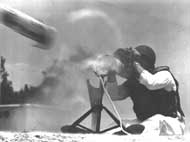1975
January 75 The first USAREUR unit was equipped with the DRAGON, and unit training started. This was the first tactical deployment of the system. It became operational in Europe in March 75, one month before the scheduled initial operational capability (IOC) date.

9 January 75 MICOM awarded Hughes Aircraft Company a $108.4 million contract for the technology transfer, fabrication, and testing of the ROLAND II missile, after the developer, Euromissile, licensed Hughes and Boeing Aerospace Company to produce a U.S. version of the system.
February 75 As a result of the Turkish occupation of part of Cyprus, the United States stopped shipments of military goods to Turkey. All actions pertaining to the government of Turkey's procurement and production equipment for the 2.75-Inch Rocket were stopped by higher headquarters direction.
19 February 75 The Secretary of the Army approved the charter establishing the PM for HEL Systems at MICOM.
March 75 Deployment of the basic TOW to Korea began.
March 75 The full-scale deployment of the LANCE missile system to Italy marked the first sale of the system to an FMS customer.
19 May 75 Functions for the Improved Light Antitank Weapon (ILAW) were transferred from the Missile Research and Development Laboratory at MICOM to the Office of the PM for the 2.75-Inch Rocket System, although the ILAW PM reported directly to the MICOM Commander. ILAW functions were not formally merged with the 2.75-Inch Project Office.
June 75 A partially deployed status was achieved for the first HAWK tactical batttery in Iran. The IOC date of 1 June 75 was not met because of Iranian problems.
9 June 75 The engineering change proposal to extend the range of the TOW to 3,750 meters was approved.
25 June 75 The 55th U.S. Army Band, which had been assigned to Special Troops, RASA, was inactivated and its personnel were assigned to other Army bands.
7 July 75 After the German-French ROLAND missile system was chosen to fill the U.S. Army's SHORADS role, the SHORADS Project Office was redesignated the U.S. ROLAND Project Office effective this date. DA also approved the organization's PM charter.
11 July 75 Redstone Arsenal, Health Services Command, and MEDDAC officials participated in a ground breaking ceremony for a new 40-bed hospital to be built off Goss Road.
15 July 75 Effective this date, the Kuwait Missile System Management Office (Provisional) was officially established as the Office of the PM, Kuwait Missile Systems Program.
August 75 The first Improved HAWK battalion in Korea&mdashthe 1st Battalion/2d ADA&mdashwas converted to the new system in August and November.
August 75 The first laser output from the Mobile Test Unit (MTU) laser module in the laboratory configuration occurred.
October 75 The Kuwait-Missile Systems Project Office received responsibility for FMS sales to Jordan.
1 October 75 MG George E. Turnmeyer assumed command of MICOM after MG Vincent H. Ellis was named to command the Defense Property Disposal Service in Battle Creek, Michigan. General Turnmeyer had formerly served as Deputy Commander of MICOM.

1 October 75 The vehicle safety inspection program for RSA began.
3 October 75 The Cannon Launched Guided Projectile (CLGP) program achieved a significant milestone when one of the projectiles scored a direct hit on an M48 tank at WSMR while being targeted by a laser in the PRAIRIE II remotely piloted vehicle (RPV). This was the first attempt to use a remotely controlled airborne designator to provide the laser spot on which the guided projectile homed.
10 October 75 The functions of the Special Assistant for the Improved HAWK-Iran Program were transferred to the HAWK Project Office.
November 75 Deployment of the TOW/COBRA began with the first fieldings to the U.S. Training and Doctrine Command (TRADOC) during this month. The system's IOC date was met in March 76.
7 November 75 The first 7-inch terminal homing flight test vehicle/current optical contrast seeker missile was flight tested at RSA's Test Area No. 1. Part of the guidance system integration and verification program being conducted by MICOM, the firing marked a "first" for the Army: the launch from a helicopter of a guided missile equipped with an optical contrast seeker. This flight test demonstrated that an optical contrast seeker could maintain lock on the target during the helicopter launch environment and through the missile flight environment.
16 December 75
The ILAW Project Office charter was approved effective this date and the project management office was established at MICOM. The system had previously been managed by the 2.75-Inch Rocket System Project Manager.
Excellence in Missilery:
Introduction,
1962,
1963,
1964,
1965,
1966,
1967,
1968,
1969,
1970,
1971,
1972,
1973,
1974,
1975,
1976,
1977,
1978,
1979
